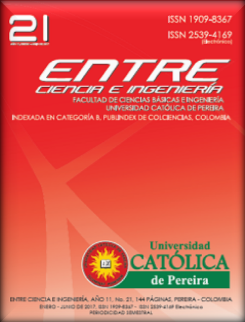Methodology and algorithm to fi nd perfect numbers in a given range of natural numbers using Functional Programming
DOI:
https://doi.org/10.31908/19098367.3283Keywords:
algorithm, perfect number, natural number, computer programming, functional programmingAbstract
This article explains a model of teaching computer programming applied to the solution of a specific problem from functional programming paradigm establishing a relationship to the student, academically among the topics covered in mathematics and possibility of capitalizing computer technology to solve it. This research used the method of study and solution of a specific case from the perspective of mathematical logic implementation developed in the first course of computer programming in Systems Engineering. The results show an assimilation, appropriation, application and feedback conducted so that it has been applied, by students in similar exercises from the perspective of autonomous learning and active participation. The conclusion is that the solution of mathematical problems from programming is an area that could be exploited much more, from the teaching, to reach learning goals of student and that this strategy enable selflearning and active learning.
Downloads
References
Fríes, E., Monzón, G., & Di Paolo, J. Resolución de una situación problemática mediante la utilización de TIC. (A. C. ACOFI, Ed.) Revista Educación en Ingeniería, 9(17), pp. 45-52. Junio 2014.
Attard, A., Di Ioio, E., & Geven, K.. Student Centered Learning. An insight into theory and practice. Bucarest: Lifelong Learning programme - European Community. 2010, p. 52.
Trejos Buriticá, O. Significado y Competencias. Pereira: Papiro. 2013, p. 39.
Van Roy, P. Concepts, Techniques and Models of Computer Programming. Estocolmo: Université catholique de Louvain. 2008, p. 112.
Kaasboll, J. Exploring didacti models for programming. Oslo: Universidad de Oslo. 1999, p. 12.
Romero Chaves, C., & Rosero Sosa, M. Modelo de Enseñanza y su relación con los procesos metacognitivos en programación de sistemas. (A.C.ACOFI, Ed.) Revista Educación en Ingeniería, 3. Junio 2014.
Schildt, H. C++ Programming. Vancouver: McGraw Hill. 2010, p. 354.
Deitel & Deitel. C++ Programming. New York: Prentice Hall. 2013, p. 220.
Unesco. http://portal.unesco.org. Recuperado 15 jun 2016, de www.eduteka.org:file:///C:/Users/EQUIPO/Desktop/Unesco%20Estandares%20TI%20Docentes%2028p.pdf. 8 de enero de 2008.
Brassard, G., & Bratley, P. Fundamentos de Algoritmia. Madrid: Prentice Hall. 2006, p. 97.
Skiena, S. The Algorythm design manual (2a Edición ed.). New York: Springer. 2008, p. 45.
Boyer, C. Historia de la Matemática. Madrid (España): Alianza Editorial. 2010, p. 611.
Rey Pastor, J., & Babini, J. Historia de la Matemática. Barcelona (España): Editorial Gedisa. 2005, p. 212.
Felleisen, M., Findler, R., Flat, M., & Krishnamurthi, S. How to design programas (2a Ed. ed.). Boston: MIT Press. 2013, p. 39.
Schildt, H. C Programming. México: McGraw Hill. 2010, p. 552.
Van Roy, P. (2008). Techniques and methods in programming computer. Louvaine: University Press. 2008, pp. 342 – 345.






 Revista Entre Ciencia e Ingeniería
Revista Entre Ciencia e Ingeniería .png) entrecei@ucp.edu.co
entrecei@ucp.edu.co.png) ISSN (Impreso) 1909-8367 - ISSN (En Línea) 2539-4169
ISSN (Impreso) 1909-8367 - ISSN (En Línea) 2539-4169 Attribution-NonCommercial 4.0 International (CC By-NC 4.0)
Attribution-NonCommercial 4.0 International (CC By-NC 4.0)
.png) Carrera 21 No. 49-95 Av. de las Américas, Pereira, Risaralda, Colombia
Carrera 21 No. 49-95 Av. de las Américas, Pereira, Risaralda, Colombia